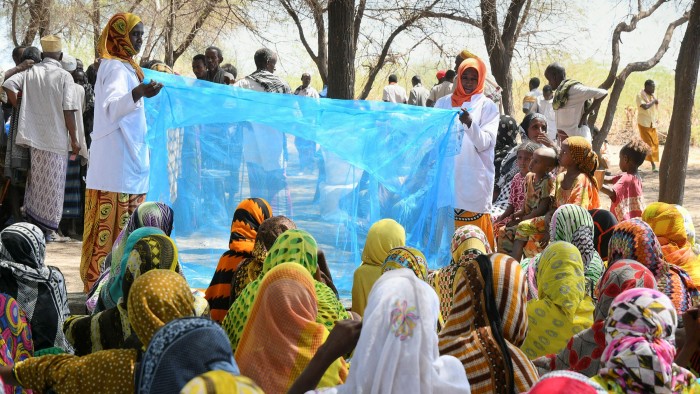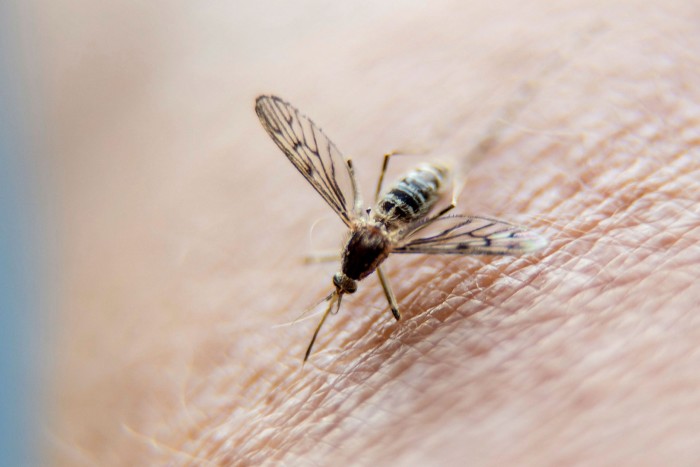Climate change threatens to reverse progress in fight against malaria

Roula Khalaf, Editor of the FT, selects her favourite stories in this weekly newsletter.
Since the turn of the millennium, 13 countries, including China and Algeria, have declared victory in the war against malaria, joining more than 100 states certified malaria-free by the World Health Organization.
The WHO aims to add at least 25 more countries to the list by 2025. But the arc of progress could yet be thrown off course by climate change.
“There’s cause for celebration and concern,” says Wakgari Deressa, professor of public health at Addis Ababa University, who has advised the Ethiopian government on malaria prevention.
Ethiopia is one of only half a dozen African nations on course to meet the WHO target of a 90 per cent reduction in malaria case incidence by 2030, compared with 2015 levels. Malaria still kills more than 400,000 people a year worldwide, mostly children under the age of five in Sub-Saharan Africa.
Malaria accounted for 10,400 deaths in Ethiopia at its peak in 2000. Now, yearly deaths from the disease are less than half that figure. Infection rates among the at-risk population have fallen from 219 cases per 1,000 in 2004 to 32 cases in 2018.
“Mosquito nets and better treatments have reduced malaria prevalence and morbidity in Ethiopia,” explains Deressa. “But, simultaneously, temperature changes and different rainfall patterns mean malaria is emerging in highland communities previously protected from the disease.” He says climate change has made elimination “a distant hope”.
The ideal conditions for malaria transmission are an average temperature of 20-30 degrees Celsius, monthly precipitation in excess of 80mm, and relative humidity greater than 60 per cent. Changes in Ethiopia’s climate have brought more regions into this malaria ‘sweet spot’.

The same trend is being seen globally: while better public health has contained the risks of malaria, climate change has made the effort “more of an uphill struggle”, says Rachel Lowe, an associate professor at the London School of Hygiene and Tropical Medicine.
A research team, of which Lowe was a part, estimated that climate change could lead to at least an additional 3.6bn people being at risk from malaria by 2071, relative to the at-risk population in 1970-99. Lowe fears complacency may creep into the fight against malaria and heighten the risk of re-emergence.
The upshot may be that countries pushing towards elimination never achieve the goal and those declared free of the disease risk the return of malaria, alongside other mosquito-borne diseases such as dengue, says Lowe.
Even parts of Europe, where the disease was officially eliminated in 2015, could see malaria return in the next few decades, warns Alexander More, associate professor of environmental health at Long Island University in New York.
“The pathogen itself is not in the environment in the quantity needed for an outbreak yet,” he says. “But [Europe’s] proximity to places where the disease is endemic means this is always a possibility from trade and human migration.”
Malaria-free areas may also face a higher degree of morbidity if the disease is reintroduced because of a lack of natural immunity, according to Andy Morse, professor of climate impacts at the University of Liverpool. “The problem is when it gets introduced to a new area or introduced back, that population is totally susceptible,” he says. “In Africa, it’s generally killing children, not breadwinners. But when it moves into a new area, it can be fatal across the whole age range because there’s no resistance.”
Morse thinks Europe may stave off the worst of malaria transmission unless there is “a drastic breakdown in the primary care infrastructure”.
However, Lowe points out that the Covid-19 pandemic proves that even well-funded healthcare systems in richer nations can end up at the point of near-collapse.
“It’s very much about not just waiting for it to happen and dealing with it when it arrives — it’s about doing everything that is possible to prevent that introduction and emergent spread,” she says.
More speculates that the world could end up in “a footrace” between climate change raising the risk of transmission and the development of better treatments and prevention methods.
More stories from this report
A study, led by the London School of Hygiene and Tropical Medicine, which followed 6,800 children aged between five and 17 months for three years, found that combining seasonal malaria vaccinations and prevention drugs reduced the risk of hospitalisation and death by 70 per cent.
Similarly, a University of Oxford team found that their malaria vaccine was 77 per cent effective in early-stage trials.
More says these results are “welcome”, but are unlikely to be a “silver bullet”. Instead, scientists think concerns over increased malaria transmission should focus government’s attention on the need to stop fossil fuel use and halt global warming.
“Policymakers need to put this issue front and centre because it’s the easiest way to sell the radical changes that need to happen for us to address climate change because everybody cares about their own health in the end,” More says.
“It’s good policy and it’s good science, or it’s good science and it’s good policy — depending on what your priority is.”
Climate Capital
Where climate change meets business, markets and politics. Explore the FT’s coverage here.
Are you curious about the FT’s environmental sustainability commitments? Find out more about our science-based targets here
Comments